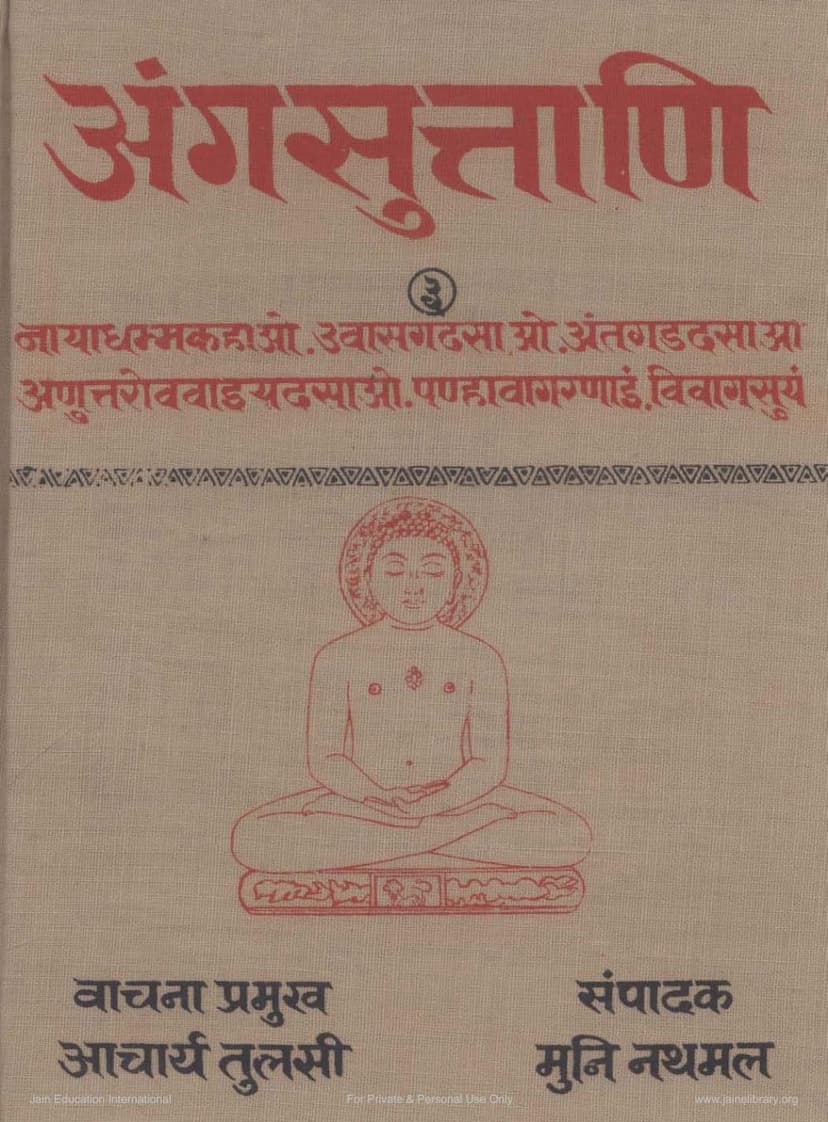Agam 10 Ang 10 Prashna Vyakaran Sutra Panhavagarnaim Terapanth
Added to library: September 1, 2025

Summary
This is a comprehensive summary of the Jain text "Agam 10 Ang 10 Prashna Vyakaran Sutra Panhavagarnaim Terapanth," authored by Tulsi Acharya and Nathmalmuni, and published by Jain Vishva Bharati. The provided text includes pages from the original work and its English preface/introduction.
Book Title: Agam 10 Ang 10 Prashna Vyakaran Sutra Panhavagarnaim Terapanth Author(s): Tulsi Acharya, Nathmalmuni Publisher: Jain Vishva Bharati Catalog Link: https://jainqq.org/explore/003566/1
Overview:
The book is a critical edition and publication of the Anga Suttāni (part of the Jain Agamas), specifically focusing on the six Angas: Nayādhammakahāo, Uvāsaga dasāo, Antagaḍa dasāo, Aṇuttarovavāiya dasāo, Paṇhāwāgaraṇāi, and Vivāgasuyam. This compilation represents the third part of the larger "Anga Suttāni" series.
The publication was undertaken to commemorate the 25th Nirvana Centenary of Lord Mahavir. Acharya Tulsi was the Vachana Pramukha (Chief authority for interpretation and guidance) and Muni Nathmal was the Editor.
Key Aspects and Content:
-
Context and Motivation: The publication is a result of a long-held desire by Acharya Tulsi for a scholarly and critical edition of the Jain Agamas. The project was initiated and supported by various individuals and institutions, reflecting a societal commitment to preserving and disseminating the sacred Jain literature. Jain Vishva Bharati, established with the vision of promoting Jain knowledge, played a central role.
-
The Angas Covered: The book specifically deals with the following six Angas of the Dwadasangi (Twelve Limbs of the Jain canon):
- Nāyādhammakahāo (Fifth Anga): This Agama, meaning "religious fables," contains both historical illustrations and imaginary tales. It expounds spiritual principles like non-violence, sensory control, and faith through various narratives. The content is praised for its literary style and vivid descriptions.
- Uvāsaga dasāo (Sixth Anga): Known as "The Biographies of Lay Devotees," this Agama details the lives of ten principal lay disciples (Upāsakas) of Lord Mahavir. It outlines the twelve vows prescribed for lay followers, emphasizing their importance as an ethical code for householders.
- Antagaḍa dasāo (Seventh Anga): This Agama, meaning "The States of Those Who Have Reached the End," narrates the stories of individuals who have attained liberation by ending the cycle of birth and death. It contains information about Vasudeva Krishna and his family, and highlights the significance of internal spiritual practice.
- Aṇuttarovavāiya dasāo (Eighth Anga): This Agama, "The States of Those Born in the Anuttara Heavens," describes the lives of monks who attained rebirth in the highest heavens. It features the opulent and ascetic lives of many princes and individuals who achieved spiritual heights.
- Paṇhāwāgaraṇāi (Ninth Anga): Titled "The Question-Explanations" or "The Analysis of Questions," this Agama deals with various queries, sciences, and divine dialogues. It addresses questions based on cause and inference, and clarifies worldly and Vedic meanings. The available content focuses on the five Aśravas (causes of influx of karma) and the five Samvaras (cessation of influx of karma).
- Vivāgasuyam (Tenth Anga): This Agama, "The Fruits of Actions," describes the consequences (Vipāka) of both good (Sukrita) and bad (Duskrita) deeds. It is divided into two sections: the consequences of bad deeds and the consequences of good deeds, illustrating how actions affect one's physical and mental state.
-
Editorial Process: The text emphasizes a critical editing approach, not relying on a single manuscript. Instead, the editors considered अर्थ-मीमांसा (interpretation of meaning), पूर्वापरप्रसंग (contextual coherence), पूर्ववर्ती पाठ (preceding texts), other Agama texts, and commentary (Vritti) to determine the authentic original text. The text also notes instances of textual variations and potential scribal errors, explaining how these were resolved.
-
Manuscript Basis: The text provides an extensive introduction to the various manuscripts used for the critical edition, detailing their origin, estimated age, and specific characteristics. This highlights the scholarly rigor applied to the project.
-
Dedication and Contribution: The book is dedicated to the spiritual leaders and all those who contributed to its realization. Acharya Tulsi expresses profound gratitude to Muni Nathmal and other collaborating monks (Muni Dulharaj, Muni Sudarshan, Muni Madhukar, Muni Hiralal) for their dedicated efforts in text revision and editing. The financial assistance from Sri Ramlal Hansraj Golchha is also gratefully acknowledged. The printers, S. Narayan & Sons, are also mentioned for their contribution to the printing work.
-
Significance: The publication is presented as a significant offering to the public during the 2500th Nirvana Day of Lord Mahavir, aiming to spread the Lord's teachings through these critically edited texts. The editors express hope that the work will serve as a foundation for future research into the Anga Sutras.
Structure of the Publication:
- Introductory Pages: Title pages, acknowledgments, publisher's note, editorial board details, and publication information (date, price, printers).
- Dedication: A poem and a statement of satisfaction from Acharya Tulsi.
- Publisher's Note: Outlines the journey of establishing Jain Vishva Bharati and its commitment to Agama publication.
- Editorial Preface: Details the scope, methodology, and significance of the critical edition.
- Detailed Analysis of Each Agama: Each of the six covered Angas is discussed in terms of its title (Nam-bodh) and content (Vishay-Vastu), citing various commentaries and traditions.
- Index/Reference: A guide to symbols and abbreviations used in the text.
- Main Text: The critical edition of the six Agamas, with footnotes and references.
In essence, this book is a scholarly endeavor to present a foundational part of the Jain Agamas in a reliable and accessible format, contributing significantly to Jainological studies and the propagation of Jain philosophy.